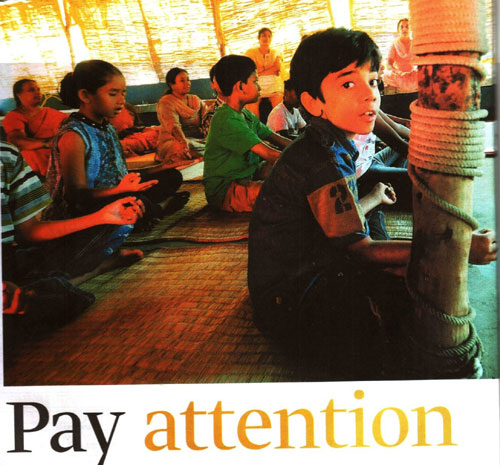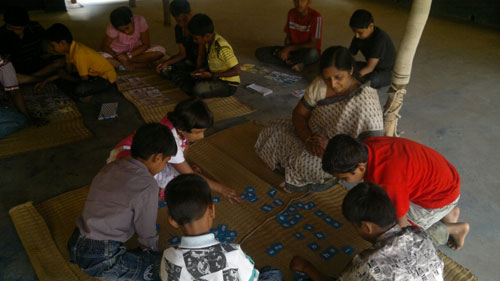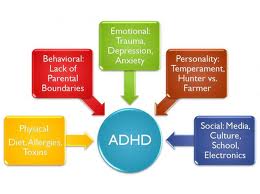ADHD – Attention Deficit Hyperactivity Disorder
What is ADHD?
Attention Deficit Hyperactivity Disorder or ADHD is a common childhood illness. People who are affected can have trouble with paying attention, sitting still and controlling their impulses. There are three types of ADHD. The most common type of ADHD is when people have difficulties with both attention and hyperactivity. This is called ADHD combined type. Some people only have difficulty with attention and organization. This is ADHD inattentive subtype or Attention Deficit Disorder (ADD). Other people have only the hyperactive and impulsive symptoms. This is ADHD hyperactive subtype.

Studies show that ADHD may affect certain areas of the brain that allow us to solve problems, plan ahead, understand others’ actions, and control our impulses.
20 percent of ADHD children have learning disabilities and about 80 percent have academic problems.
How common is ADHD?
An estimated 3 to 5 percent of preschool and school-age children are effected by ADHD.. Therefore, in a class of 25 to 30 children, it is likely that at least one student will have this condition.
ADHD begins in childhood, but it often lasts into adulthood. Several studies done in recent years estimate that 30 to 65 percent of children with ADHD continue to have symptoms into adolescence and adulthood. 20 percent of ADHD children have learning disabilities and about 80 percent have academic problems.
What causes ADHD?
No one knows exactly what causes ADHD. There appears to be a combination of causes, including genetics and environmental influences Several different factors could increase a child’s likelihood of having the disorder, such as gender, family history, prenatal risks, environmental toxins and physical differences in the brain seem to be involved.

Common signs and symptoms of ADHD
A child with ADHD often shows some of the following:
Difficulties with attention:
- trouble paying attention
- inattention to details and makes careless mistakes
- easily distracted
- losing things such as school supplies
Hyperactivity:
- fidgeting
- inability to stay seated
- running or climbing excessively
- always “on the go”
Impulsivity:
- talks too much and interrupts or intrudes on others
- blurts out answers and impatience
Hyperactive children can be awfully difficult to live with and next to impossible to educate. Add in violent behavior and they can be impossible to live with.
What are the consequences of Untreated ADHD?
Without treatment, a child with ADHD may fall behind in school and have trouble with friendships. Family life may also suffer. Untreated ADHD can increase strain between parents and children. Parents often blame themselves when they can’t communicate with their child. The sense of losing control can be very frustrating. Teenagers with ADHD are at increased risk for driving accidents. Adults with untreated ADHD have higher rates of divorce and job loss, compared with the general population. Luckily, safe and effective treatments are available in Homoeopathy, which can help children and adults help control the symptoms of ADHD and prevent the unwanted consequences.

Trio approach
Medication – Therapy – Counseling
- “SATTVAM ” has conducted a random evaluation of about 4000 children over a period of 8 yrs ,which showed…. almost 51 % of children underperforming and undiagnosed…. of which 21% of the children had either markers of ADHD or Frank ADHD.
- 34% Inattentive type, 29% HI type, & 37% Combined type.
- 60 % of children who came had tried/taken some treatment or therapy prior to coming.
- 40 % of children came directly …for the 1st time without any treatment or therapy taken earlier.
- Improvement seen in children with only Specific Homoeopathic medication in a 8 month window is 65% to 70%.
- In remaining 40% cases, only 15% of the parents of the 65% were open to taking up therapy along with treatment.
- Presented papers in international & National conferences on ADHD and its comprehensive approach.
How Does Homoeopathy Help in Attention Deficit Hyperactive Disorder
Homoeopathic drugs have a favorable and positive effect on the brain. They act as nerve tonics, predominantly,
- Reducing child’s hyperactivity, irritability & violence
- Influencing defective”motor patterns”and improving coordination reducing difficulties of perception.
- Correcting the altered state of sensitivity.
- Improving behavioral problems.
- Enhancing attention span.
- Managing underlying neurological and metabolic disturbances.
- Controlling involuntary movements, and improving coordination.
- Acting as immunomodulators: Improving general resistance power without any adverse effects
Tips for Parents raising children with ADHD
On homework
- Take short breaks every 15 to 20 minutes.
- Self monitor by having the child periodically record how many problems he or she has accomplished.
- Have a quiet place for homework.
- Work on one task at a time.
- Divide tasks into small steps.
- Walk around the room and talk out loud to memorize.
- Pick a time of day when the child is not tired or hungry.
On self-esteem
- Make a list of things a child likes about himself or herself.
- List activities the child enjoys or is proficient at.
- Encourage being positive.
Tips to Teachers for children with ADHD
Structuring the environment
- Seat the student in the least distracting area of the classroom. Avoid seats near hallways, doors, windows, or high traffic areas.
- Seat the student close to you, if possible, or surround him with positive role models.
- Set clear rules and display them in plain view, along with logical consequences and rewards.
- Facilitate peer tutoring. Include chances for the student to help a struggling peer.
Structuring time
- Schedule activities that demand more attention in the morning.
- Post a daily schedule in the classroom and refer to it often. On days when you will change the schedule, announce the change in advance and give ample reminders.
- Allow several minutes each day for students to organize their desks, gather assignments, and make a plan for completing homework.
Structuring tests
- Give frequent, short quizzes instead of longer tests. Provide practice tests.
- Try to avoid timed tests if possible, allow extra time for the student, or consider allowing the student to give oral answers.
Organizing assignments
- Consider giving the student shorter assignments or break assignments into smaller units.
- Avoid putting too much information on each page. Use borders, colors, or highlighting to emphasize key directions or important points.
- Consider using a daily assignment notebook to make sure the student has recorded assignments correctly. Parents can sign it to indicate the student has completed assignments.
- Help students remember to turn in homework (it often really IS in the backpack).
Focusing attention
- Use prearranged verbal or visual cues to correct behavior. Make frequent eye contact.
- Consider allowing the student to use headphones with soft music to block auditory distractions during individual work.
Planning appropriate movement

- Alternate physical and mental activities, or design lessons that involve movement as part of learning.
- Involve the student in distributing papers, watering plants, or sharpening pencils. Presenting information and directions
- Give students a lesson outline ahead of time, with key concepts and vocabulary identified.
- Make lessons brief, or break them into short segments. During lessons, give students opportunities to respond in a variety of ways.
- If presenting information on a board, use color to emphasize key points.
- Make directions clear and simple. Give them one step at a time, and ask students to rephrase in their own words. Reinforce verbal directions by displaying or distributing them in print. Rewarding appropriate behavior
- Develop a classroom behavior management system that rewards students for appropriate behavior and completion of work. Seek out and reward success as much as possible.
- Use activity as a reward instead of prizes. Always pair rewards with praise.





